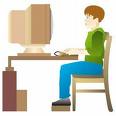| ASSISTIVE TECHNOLOGY |

atto.buffalo.edu
|
 atto.buffalo.edu |
|
Assistive Technology can help with written expression as well as the physical act of putting words on paper. The following are examples of various technologies, from low-tech to high-tech, that can help with the writing process: LOW TECH WRITING AIDES *Pencil Grips building up the shaft of a pencil for easier writing. *Incline Board writing on a 15-30 degree surface helps writers get better control of the paper. *Bold -lined or Raised- lined Paper helps writers stay on the lines. *Writing guides Plastic guides for one to multiple lines provide more of a guide than raised lines. *Word Lists either commercial or individually made, provide models for correct spelling. *Wipe-Off Boards beginning writers can practice using personal dry-erase boards. MID TECH WRITING AIDES *Electronic Spell Checkers the user can make a guess at spelling and get a list of possibilities. Auditory feedback is available in more expensive versions. Example: Franklin Childrens Speller and Dictionary. *Portable Word Processors allows users to use keyboarding to write. They have spell check, limited editing, and some have word prediction. Most run on batteries, require no boot- up time, and weigh less than 2 pounds. Example: AlphaSmart. *Recorders analog and digital recorders can be used to take lecture notes, or be used for dictating or brainstorming. Recorders can capture lectures for speech-to-text conversion. HIGH TECH WRITING AIDES (HARDWARE) *Computers eliminate handwriting problems through keyboarding, makes proofreading easier because text is more legible. *Alernative Keyboards enlarged keyboards, alternative keyboard layouts, sticky keys (press one key instead of two). Examples: Discover: Board, Intellikeys. *Cursor Control trackballs, joysticks, trackpads, and touch screens. HIGH TECH WRITING AIDES (SOFTWARE) *Word Processor features most word processors have features such as Auto Correct, Auto Text, Spell and Grammar checks, Dictionary and Thesaurus, highlighting pens, Auto Summarize, and various font sizes and colors. *Auditory Word Processors gives auditory feedback after user types a letter, word, and/or sentence. Examples: Kurzweil, WYNN, Premier. *Word Prediction/Completion programs displays a list of words after a user types several letters. Examples: Aurora Prediction, EZ Keys, Write Away 2000. *Speech Recognition Software people with consistent speech can use this software to write. There is a need for a training period. Examples: Dragon NaturallySpeaking. *Outlining/Brainstorming Software helps the writer to organize their thoughts for a writing project. Examples: Inspiration, Kidspiration, Draftbuilder. |
Links: |